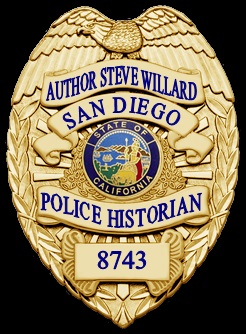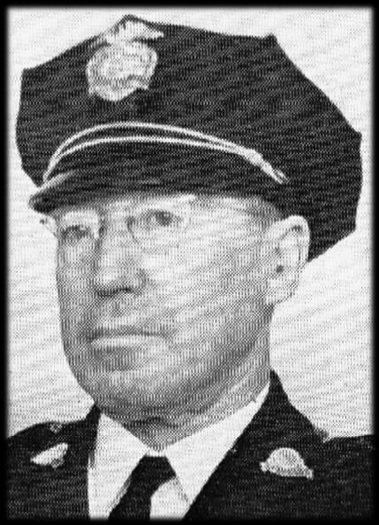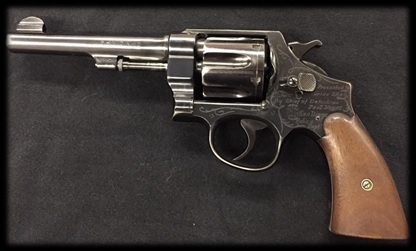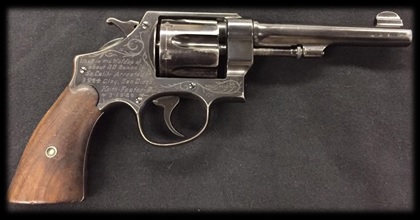


Wednesday, January 5, 1927: Los Angeles, California. When the United States National Bank at Twelfth and Olive Streets was knocked off shortly after opening, nothing distinguished the job as the first in a spectacular series of holdups across Southern California.
LAPD detectives reported four suspects pulled the stickup. As one robber waited in a car, his partners—two white men and a black man—strolled into the bank. One of the white men pulled a 1917 Smith and Wesson blue steel .45-caliber revolver and then quickly jumped the teller counter, demanding money from the terrified bank employees.
A second robber brandished a shotgun to herd the customers into a corner. As the duo held everyone captive, the black robber smiled as he went from teller to teller helping himself to stacks of cash.
Not a word was spoken among the stickup men. With the cash stuffed into a nondescript burlap sack, the men casually walked to the waiting sedan and drove away.
The entire robbery took less than five minutes.
One bank employee copped a license plate. LAPD uniformed officers located the car abandoned three blocks away. A make on the registration revealed it had been rented in cash under a fictitious name from the Hertz Driveurself station on the far edge of town.
Several bank employees spent the afternoon at LAPD headquarters looking through a mug book of known stickup artists. Nothing.
Tuesday, March 29, 1927: The robbers struck again, this time at the Bank of Italy on the corner of Melrose and Western in the city of Los Angeles. Like the previous caper, the getaway car, a rented Cadillac, was recovered three blocks away. Like the January robbery, it, too, had been leased by a man using a fictitious name.
The suspects’ description led newspapers across the Southland to dub the trio “The Black and White Bandits.”
Tuesday, August 23, 1927: Newshawks eagerly reported the gang’s third robbery, also in L.A. While the time and date were new, the MO was the same: the gang came, they saw and they conquered. This time, the haul was almost $6,800 in cash (more than $96,000 in 2017 dollars).
Egged on by the press, which slammed the LAPD, the public was outraged. Something had to be done.
Then the bandits moved south.
In 1927, the city of San Diego could boast of never having had an unsolved bank robbery. With the ocean to the west and an international border to the south, the SDPD was famous for simply closing down the four arterial highways leading out of town and shaking down every car attempting to leave the city as patrolmen searched the neighborhoods. This earned San Diego the distinction as America’s toughest town to rob.
Tuesday, December 27, 1927: The Security Commercial Bank at Fifth and University Avenue in San Diego was robbed of $6,208. Cops confidently swung into action.
Chief of Police Joe Doran was in his office when the [robbery] call came in. Having made most of his fifteen-year career in the Detective Bureau, he was more than qualified to assume charge of the case. His first action was to sound the alarm and close the highways leading out of town. Next, plainclothes men from the newly formed robbery unit were ordered to the scene.
As with the L.A. jobs, the getaway car was located nearby. Unlike the previous heists, the origin of the car wasn’t immediately determined. Fingerprint men from the ID Bureau spent most of the day dusting the car for prints but ultimately determined the bandits were wearing gloves.
ID Bureau assistant superintendent William A. Menke searched the vehicle and discovered a tiny receipt card between the seats. Dated December 17 from the Pan American Oil Company of Los Angeles, it was the only shred of evidence left behind.
By the end of the day, it was painfully obvious that unlike every other stickup San Diego had ever endured, closing the roads to capture the robbers didn’t work. The larcenous group had vanished somewhere within the city limits among the 147,000 people who called the area home.
Wednesday, December 28, 1927: The LAPD had been notified of the robbery in San Diego. A make on the plate came back to Lail’s Auto Rental Service at 510 West Eighth Street in Los Angeles. LAPD dicks interviewed the proprietor and discovered, as in the previous jobs, that the car had been rented under a fake name.
The tiny receipt was traced to a San Diego service station; however, the attendant couldn’t recall anything about the transaction.
With San Diego a racially segregated city, the bureau relied heavily on Detective John W. Cloud, who would ultimately retire as the SDPD’s first black sergeant, to comb a predominantly black area of restaurants, bars, pool halls and hotels south of Market Street and east of Fourth Avenue.
Farther north, white officers went from hotel to hotel, shaking down known thugs and convicts. The sweep netted several fugitives and cleared a number of arrest warrants; however, none of those arrested were members of the Black and White Gang.
The sensational new coverage overwhelmed the SDPD with phone calls and walk-in traffic. The result was that everyone on the department wound up working long hours chasing dead-end leads.
Saturday, March 3, 1928: The gang may have been feeling the heat was too much in San Diego. They struck the Citizens Trust and Savings Bank in Los Angeles.
Tuesday, May 22, 1928: The euphoria of the gang moving north proved to be short-lived when the Black and White Bandits struck the First National Bank at Thirtieth and University. SDPD robbery detectives would later discover the bandits used three cars for that specific job. The first was traced to a Los Angeles livery one week earlier. The second was rented in San Diego under a false name on the day of the robbery. The third car allowed them to safely pass through the roadblocks and head back to Los Angeles.
As frustrating as it was, the bandits were starting to get overconfident. In the last rob job, one of the stickup men was especially talkative. As he wielded a sawed-off shotgun, a white robber barked toward his victims, “Be good little boys and girls and no one gets hurt.”
Steven Stone, an employee of the County Hospital, proved to be the best clue to the May 22 case. He may also have been the most frustrating. Stone was crossing the street leading to a northbound highway when he was hit by a large sedan driven by a black man. Two white men were also in the car. Stone reported one of the men had a shotgun draped across his lap. Unfortunately, Stone waited more than a day to provide the information to anyone.
By now, banks across the Southland were on high alert. Armed guards were hidden in branches across San Diego and Los Angeles. On two occasions, minor stickup men had their tickets punched when they were met with blazing guns.
Wednesday, September 19, 1928: The bandits returned to San Diego, this time knocking over the Bank of Italy at Felton Street and Adams Avenue. The getaway car was located seven blocks away.
The best witness in this case turned out to be a six-year-old boy. He reported seeing three men—two white men and one black man—exit the car and carry a suitcase down the street. Detectives traced the getaway car to Lail’s Auto Rental Service, this one located at 746 Hope Street in Los Angeles. The franchise was across town from the Lail’s that had provided the getaway cars in previous robberies.
The press went into a frenzy. Completely disregarding past bureau successes, newspapers assailed the police department. Daily the headlines screamed, “Why Can’t the Inept Men of the SDPD Catch These Bandits?”
Chief Doran bore the brunt of the abuse. His office at 700 Second Avenue was bombarded with phone calls and letters. Some of the letters demanded his resignation; others offered “expert” advice.
Then came a break. Sheriff James Smith of Fallon, Nevada, contacted the SDPD with information on two white men and a black man arrested for robbery in his county. Detectives from the SDPD and the LAPD sped east to interview the trio. They returned empty-handed. Evidence and alibis proved they were not the Black and White Bandits.
Two more L.A. stickups—one in November and the other in December 1928—reinforced just how little the police had on the gang.
Tuesday, March 19, 1929: The gang had been operating for more than two years. Just after 10:20 a.m., a large Cadillac pulled up to the curb in front of the First National Trust and Savings at Thirtieth and University Avenue. It would be the second time the gang hit this specific San Diego bank.
As the leader of the gang was exiting the bank, the branch manager, Hal Royle, had enough. Armed with a .38 revolver, Royle opened fire on the startled robber. The bandit turned and fired back as bank employees and customers cowered in fear. As the robber [bolted] for the Cadillac, another bank employee joined in the shooting with a 30-30 rifle he had stashed in his office.
By chance, Patrolman Edward Johnstone was at a callbox across the street. When he saw the bandits, he pulled his service revolver and joined the bank employees in the lead fest directed at the robber.
One gangster jumped from the Cadillac and attempted to shoot back at Johnstone.
Motorist George Sinclair, oblivious to the unfolding mayhem, drove between the Cadillac and the policeman just when the bandit pulled the trigger. The errant bullet tore through Sinclair’s car, narrowly missing his head. Apparently not one to take such attacks lightly, Sinclair reached under his seat, pulled a .22 and began shooting back at the big Cadillac as it attempted to drive away.
Down the street, Roy Neblett, the proprietor of a radio shop, saw the mayhem and joined in the shooting with his own revolver.
A barber also ran from his shop and emptied his handgun at the Cadillac as it vanished around the corner.
Detective Lieutenant Malcolm Berrie was in his office when the call of the latest robbery came in to police headquarters. He quickly contacted Chief Doran. Within minutes, the SDPD teletype was contacting the La Jolla and East San Diego substation with Doran’s orders: “CLOSE ALL ROUTES OUT OF THE CITY AND GET ALL POLICEMAN ON THE STREETS.”
Like with all the previous robberies, the getaway car was located several blocks from the crime scene. This time, the car was riddled with more than twenty bullet holes of various calibers. An exhaustive search of the car did not locate any blood. How the bandits managed not to get struck seemed a mystery.
With the city sealed, patrolmen began canvassing the neighborhoods.
Outpost crews were also busy. Every car attempting to leave the city was stopped and searched. As the bandits were known to be armed and dangerous, each stop was conducted by officers with their side arms drawn. Some citizens were outraged and promised to call the mayor and have the officers’ jobs. Others took up seats at the roadblocks so they could watch a gunfight when the bandits tried to make it through.
Back at headquarters, Lieutenant Berrie was up to his eyeballs fielding tip calls. In the days before computers and radio-equipped cars, he was relegated to copying each tip on a scrap of paper and then waiting for officers to phone in for assignment.
One of the better tips was a sighting of a black man and two white men going into a small house at 3244 Clay Street in Logan Heights. Lieutenant John T. “Pete” Peterson quickly assembled a gang of bureau men — Detective Sergeant Mike Shea, Detective George Sears, Detective Eldridge "Tommy" Osbourne and Ray Little—and ordered them to grab cars. Along the route, they were joined by motorcycle officer Frank Merritt. The men parked two blocks from the target house.
Keenly aware they were in a predominantly black neighborhood, the Caucasian men in dark suits and fedoras that screamed police cautiously approached the house, silently hoping no one would look out the window. Officer Merritt jogged down the dirt alley abutting the rear of the house to cover the back.
Situated to the rear of 3242 Clay, the target house looked peaceful enough. Detective Shea and Detective Little quietly crept onto the porch. Holding his .45 pistol in one hand, Shea knocked on the front door. No answer. Shea knocked again. A nervous black man with beady eyes cracked open the door.
“What do you want?” the man abrasively demanded.
Shea answered by throwing his shoulder into the door with such force it knocked the man backward. In almost one motion, Shea grabbed the man and shoved him onto the porch toward Detective Little as he continued into the small living room. There, Shea found himself looking at a sawed-off shotgun leveled at his chest.
“Stick your hands up and drop that rod or I will blast you to hell!” the gunman barked. He had Shea dead to rights.
Shea quickly reached forward and grabbed the shotgun with one hand and then muscled the barrel upward toward the ceiling. With his other hand, he shoved the .45 into the crook’s stomach.
“I’m a police officer. Get your own hands up. You’re under arrest,” Shea shouted back.
No one will ever know what was going through the robber’s mind as Shea demanded the gunman drop his weapon. The slightest bit of pressure on the trigger could have taken Shea’s head off. Perhaps it was a fear of being shot in the chest by Shea if the shotgun went off that made the robber drop his weapon. The standoff was over as quickly as it had begun.
Well aware that there were other men to account for, Shea grabbed his prisoner and used him as a human shield to move toward the back of the house. As the bureau men burst into a back bedroom, they found another armed robber standing next to the bed.
“Drop your weapon!” Shea commanded. His .45 was pointed directly at the robber. Behind Shea were several other policemen, also pointing guns. The robber wisely surrendered.
For a moment, the only sound in the room was the sequential clicking of handcuffs as Peterson and Osbourne cuffed two white men, Lynn Keith and John Foster, of the Black and White Bandits.
Back at headquarters, Paul Hayes led the interrogations. An imposing figure standing well over six feet tall even without his trademark hat, Hayes was widely regarded as the best interrogator on the SDPD. He didn’t disappoint.
The trio quickly confessed to ten bank robberies in San Diego and Los Angeles. They also dropped dime on a fourth robber who had been involved in several L.A. jobs. The LAPD used the information to make an arrest the next day.
During his interview with Walter B. Miller, the black bandit, Hayes asked, “Why did you follow Keith into a life of crime?”
Miller paused and then answered, “Well, boss, Lynn was the bravest man I’d ever met except for one.”
“Who do you mean?”
Miller smiled. “That cop who arrested us.”
Days later, a host of eyewitnesses and bank employees came to police headquarters for a live lineup on the three suspects. An overwhelming number made positive IDs. The airtight cases made for rapid trials. Lynn Carter Keith, Walter B. Miller and John J. Foster were each handed terms of five years to life in Folsom. The men were also tried in Los Angeles Superior Court and received almost identical sentences, to be served concurrently.
The .45 caliber, 1917 revolver, used by the Black & White Bandits in their historic robbery series, is now an artifact in the San Diego Police Museum






Detective Sergeant Maurice "Mike" Shea displayed unbelievable bravado in arresting the
Black & White Bandits.